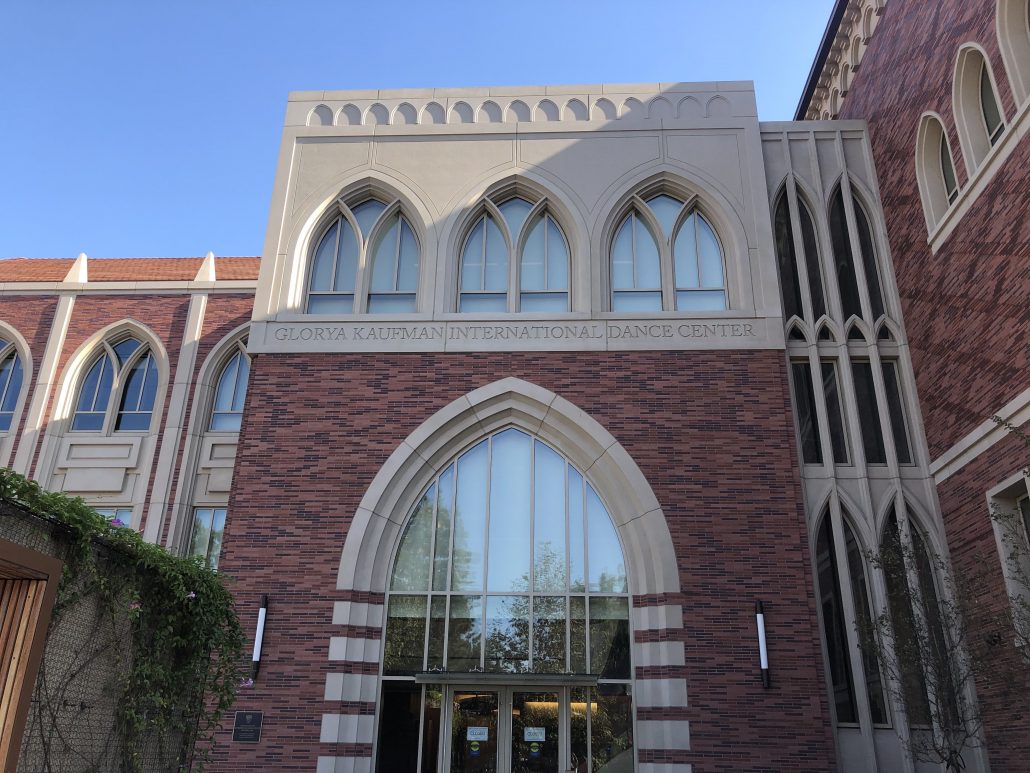Kaufman ‘MinEvent’ showcases modern, abstract dance

The courtyard by the Kaufman School of Dance is a serene oasis amid the bustling USC campus — shady and secluded, a quiet spot where dance students can study together or rehearse their steps. But on Friday afternoon, the space was unexpectedly animated, as students and their parents trickled in and congregated around the perimeter. They were there for the Kaufman “MinEvent,” a 15-minute performance of excerpts from the works of Merce Cunningham.
A pioneer in American modern dance, Cunningham was a dancer and choreographer whose work was heavily informed by Dadaist, surrealist and existentialist motifs. Along with his partner, musician John Cage, Cunningham created almost 200 original pieces during his lifetime that pushed the boundaries of movement and expression.
As Cunningham was born in 1919, this year marks his centennial celebration. The Kaufman school invited dancer and teacher Silas Riener, a former member of the Merce Cunningham Dance Company, to stage the MinEvent as a tribute to his enduring influence.
“I was fortunate enough to dance in Merce’s work and experience his final creative works before he passed away,” Riener said. “He paved the way for a lot of different kinds of experimental work. He was always trying to think of something else, always continuing to make different choices.”
This unconventional sensibility seemed to inform Riener’s staging of the MinEvent as well. The piece was performed by freshmen and sophomores, many of whom had never encountered anything quite like Riener’s process. For one, all rehearsals had been conducted in total silence; the performance was the first time the dancers heard the music that the pieces were set to.
“What was interesting … was that there was no music during the process,” Nina Gumbs, a sophomore majoring in dance who performed in the MinEvent, said. “Normally you’re going off of music, or the choreographer comes in, and she’s like, ‘You’re going to be in this spot, and this spot, and this is your cue.’ We didn’t have that kind of process.”
Riener wanted the dancing and the music to remain separate so the students could focus on pure movement with no other distractions.
“We rehearsed with a stopwatch to make sure things are the same length, but the music and the dance are separate and combined for the performances,” Riener said. “That’s been a really inspiring thing, to just really think of dance on its own terms.”
Additionally, many of the dancers were given autonomy to decide when and how they would execute the choreography. During one part of the show, dancers abruptly stopped dancing and walked offstage to stand to the side. The timing of when they decided to stop and where they would walk was up to them.
“Some parts you could choose when you went to go and where you wanted to go too,” Gumbs said. “There were sections where some people might have been standing on that structure. I was actually out and around, behind by this box, that was a choice that I could make. So it was full of choices.”
Still, a large element of the event involved careful, thoughtful preparation. Though Cunningham is known for dressing his dancers in sleek, minimal unitards, for the MinEvent, the dancers sported casual street clothes — sweatpants, leggings, tank tops and T-shirts. Yet their outfit choices weren’t simply random; Riener wanted to ensure variation and diversity among the “costumes.”
“Silas said … ‘Wear whatever you want. Nothing too baggy or anything, but I want you guys to look human,’” Gumbs said. “We all came in with different options. [Riener] wanted a mix of patterns, no patterns, shorts, dresses, everything.”
The experimentalism and pared down aesthetics of modern dance was a novel experience for the dancers and audience members alike. Katherine Free, a junior majoring in international relations, attended the MinEvent and found the performance to be on the opposite end of the spectrum from her classical ballet training.
“I normally go to more story ballet … performances,” Free said. “So to see a modern dance in an atmosphere like this where there’s not necessarily meaning, and you’re creating your own meaning between the sounds and the dancers and everything is really interesting.”
And that’s exactly what Riener hoped for: That each audience member would have their own interpretation of the performance.
“There’s no story or singular idea. There’s no thing that the dance is about,” Riener said. “People will all think different things. They’ll have an experience of moving bodies in time and space, and they’ll think whatever they think.”
Free added that she enjoyed watching the students learn and grow and be challenged by new, different forms of artistic expression.
“I’ve seen some of these dancers before in previous performances,” Free said. “So to see them growing in different fields of dance, it’s really, really nice.”

